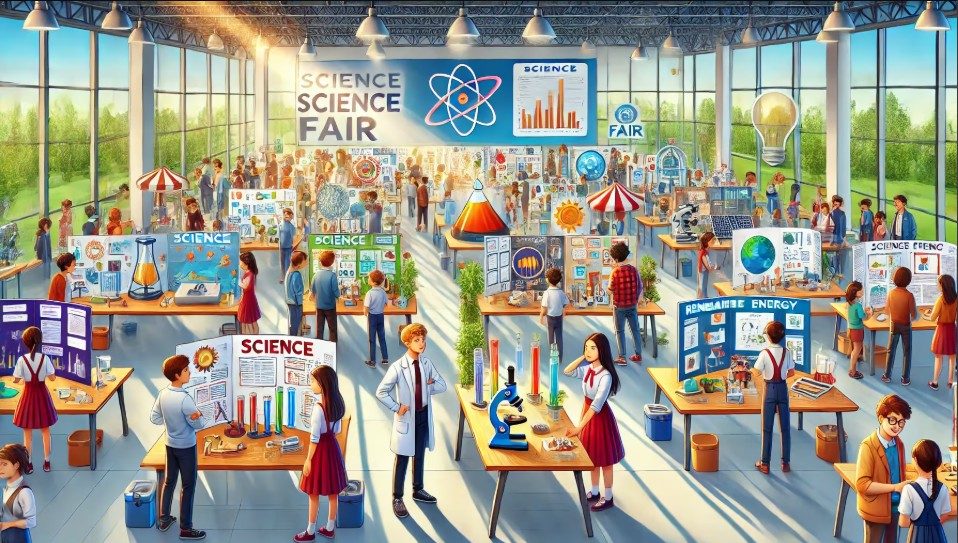JAKARTA, studyinca.ac.id – Science fairs have long been a staple of educational experiences, providing a platform for students to explore their interests in science, technology, engineering, and mathematics (STEM). These events encourage innovation, critical thinking, and creativity, allowing students to engage with scientific concepts in a hands-on manner. This article explores how science fairs work, the benefits they offer, and practical steps for organizing a successful event that inspires student innovation.
What is a Science Fair?

A science fair is an organized event where students present their scientific projects or experiments to an audience, typically including peers, teachers, and judges. Participants conduct research, develop hypotheses, and create projects that demonstrate their understanding of scientific principles. Science fairs can be held at various levels, including school, district, and regional competitions.
Benefits of Science Fairs
1. Fostering Innovation and Creativity
Science fairs provide students with the opportunity to think outside the box and explore their interests. By designing their own experiments or projects, students can express their creativity and develop innovative solutions to real-world problems.
2. Enhancing Critical Thinking Skills
Engaging in the scientific method requires critical thinking and problem-solving skills. Students learn to analyze data, draw conclusions, and communicate their findings effectively, which are essential skills in any academic or professional setting.
3. Encouraging Collaboration and Teamwork
Many science fairs allow for team projects, promoting collaboration among students. Working together fosters communication skills and helps students learn to value diverse perspectives.
4. Building Confidence
Presenting their work to an audience boosts students’ confidence and public speaking skills. This experience prepares them for future presentations and enhances their ability to articulate their ideas.
5. Connecting Classroom Learning to Real-World Applications
Science fairs bridge the gap between theoretical knowledge and practical application. Students see firsthand how scientific concepts are relevant to everyday life and societal challenges.
How Science Fairs Work: The Process
1. Planning the Science Fair
Experience
Successful science fairs require careful planning and organization.
Steps Involved
- Set Goals: Define the objectives of the science fair, such as promoting STEM education or encouraging critical thinking.
- Choose a Date and Venue: Select an appropriate date and location for the event, ensuring it accommodates participants and visitors.
- Establish Guidelines: Create clear guidelines for project submissions, including eligibility, project types, and judging criteria.
2. Encouraging Student Participation
Experience
Engaging students early on is crucial for a successful science fair.
Steps Involved
- Promote the Event: Use posters, announcements, and social media to generate excitement and encourage participation.
- Provide Resources: Offer resources such as project ideas, research materials, and access to mentors or teachers who can guide students.
- Host Workshops: Organize workshops to help students understand the scientific method, project development, and presentation skills.
3. Project Development
Experience
Students should be guided through the project development phase to ensure a meaningful learning experience.
Steps Involved
- Select a Topic: Encourage students to choose topics that interest them and are relevant to scientific principles.
- Conduct Research: Guide students in conducting thorough research to support their projects, emphasizing the importance of credible sources.
- Design and Execute Experiments: Help students design experiments or projects that test their hypotheses, ensuring they follow safety protocols.
4. Preparing for Presentation
Experience
Preparation for the presentation is key to building confidence and effective communication.
Steps Involved
- Create Display Boards: Encourage students to create informative display boards that summarize their projects, including objectives, methods, results, and conclusions.
- Practice Presentations: Provide opportunities for students to practice their presentations, offering constructive feedback to improve their delivery.
5. Judging and Feedback
Experience
Judging provides valuable feedback and recognition for students’ efforts.
Steps Involved
- Select Judges: Recruit knowledgeable judges from the community, such as teachers, scientists, or industry professionals, to evaluate the projects.
- Establish Judging Criteria: Develop clear criteria for judging projects, considering aspects such as creativity, scientific method, presentation, and understanding of the topic.
- Provide Feedback: After the fair, offer feedback to participants, highlighting strengths and areas for improvement to encourage future participation.
6. Celebrating Achievements
Experience
Recognizing students’ efforts fosters motivation and encourages continued interest in science.
Steps Involved
- Award Prizes: Consider offering awards or certificates for various categories, such as Best in Show, Most Innovative, or Best Presentation.
- Showcase Projects: Create opportunities to showcase projects to the wider school community, such as open houses or exhibitions.
Conclusion
Science fairs are powerful tools for encouraging student innovation and engagement in STEM education. By providing a platform for exploration and creativity, these events help students develop critical thinking skills, build confidence, and connect classroom learning to real-world applications.
By following the outlined steps to plan and execute a successful science fair, educators can inspire young minds and cultivate a lifelong passion for science and discovery. As students embark on their scientific journeys, they not only learn about the world around them but also develop essential skills that will serve them well in their future endeavors.
Improve Your Abilities: Explore Our content on Knowledge
Take a Look at Our Latest Article on Exam Preparation!

